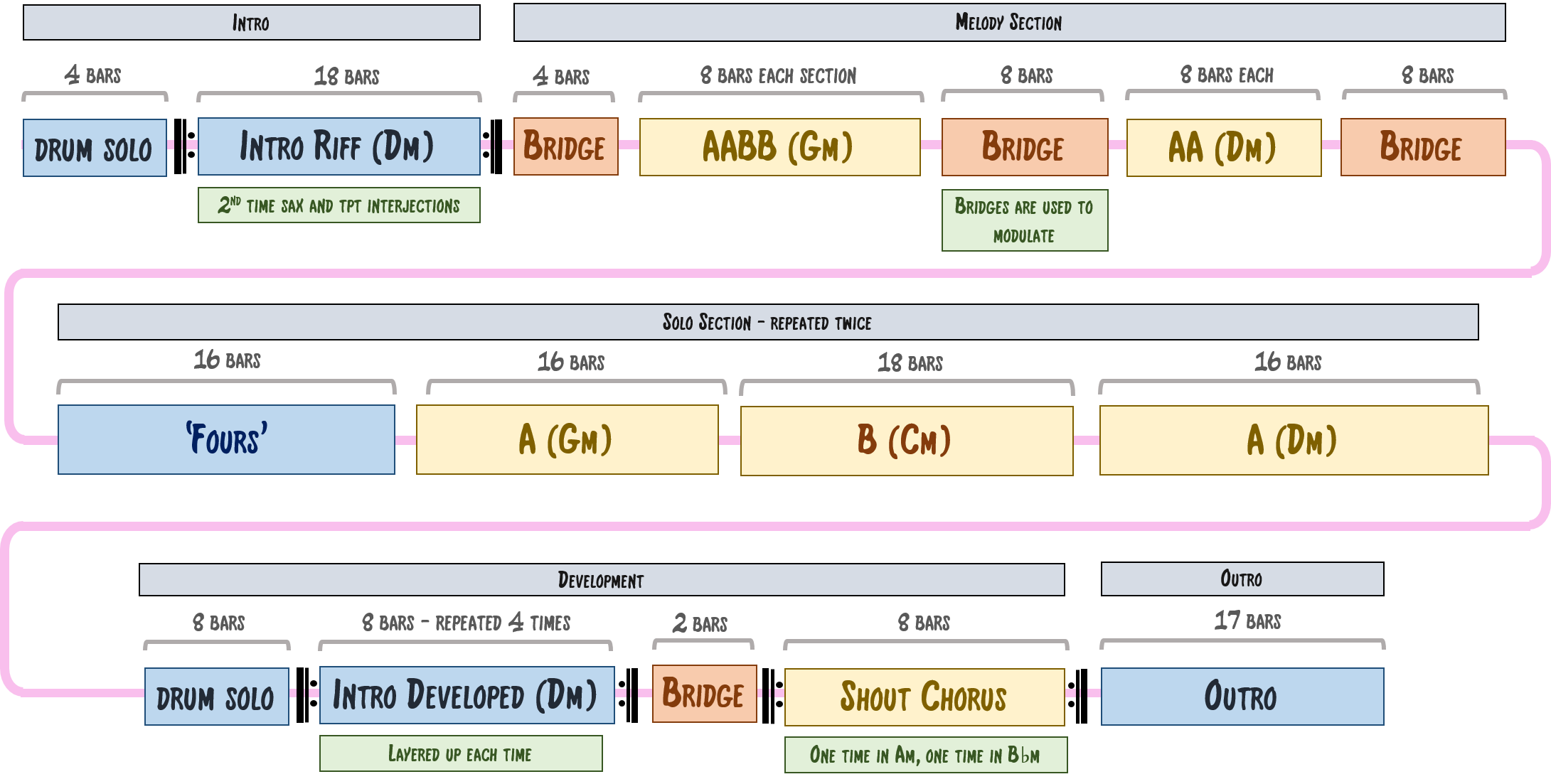20 | Full Chart Analysis
To wrap up everything I’ve been through so far, I’m going to show my method for analysing a big band chart in a meaningful way. If you’ve followed me through my other articles this far, you’ll have seen some of my ways of colour-coding voicings etc. By breaking down an arrangement, you can kind of reverse-engineer it to help with the writing process. Here’s my full analysis process:
Make a structural diagram.
Make a reduction of melody and harmony.
Make a reduction of the voicings.
Make note of any supporting textures/background figures.
Look at the rhythm section writing.
Look at any other key features of the chart.
For the full analysis, I’ve taken one of my favourite modern charts - Sing Sang Sung by Gordon Goodwin, based on the traditional classic by Benny Goodwin. If you haven’t already - take a listen now. Let’s follow the steps in order.
1. STRUCTURE
Here’s a diagram showing the form of Sing Sang Sung. I make these for a lot of my favourite charts. The colours show idea, material or chord progressions that are related:
It’s not a completely usual structure, especially with regards to key centers, but it still broadly does what a typical big band arrangement does.
2. LEAD SHEET
Next, I’ll take the melody and harmony and create a lead sheet or score reduction. I’ll often just do a quick, handwritten sketch of the melody and chords. It’s really important to play through this and get it under your fingers on whatever instrument you choose. Because this is such a big tune rather than a simple melody & chords kind of thing, I actually transcribe and make a reduction of as many parts as possible. I’ve included part of it here so you get the idea.
VOICINGS
After that, I’ll start looking at horn reductions. This is the most time consuming part. I’ll be looking at two things in particular:
Substituted notes with relation to the harmony. (9ths instead of roots etc.)
Actual voicings. (close, drop-2, open etc.)
How the voicings are linked. (Where do the horns interlock etc.)
I use colours for this kind of thing. Here’s an example of the intro soli:
4. OTHER MATERIAL
Now I’ll look at any parts I haven’t already. I’ve already looked at the melody, harmony and any harmonised version of the melody, so it’s usually looking at background figures and pads. I analyse these in any way that seems appropriate to the figure. Sometimes making a voicing reduction is appropriate, sometimes the effect is obvious and sometimes it’s simply looking at unison or octave textures. Here’s an example of the trombones backing the same soli:
5. RHYTHM SECTION
The rhythm section in most charts is usually fairly straightforward to look at and gain an understanding of what’s going on. I’ll have a scan through anyway and have a look for anything that is unique to the chart or particularly interesting - maybe a written out bassline or guitar melody. Grooves, riffs and vamps are all good to look at here too as well as anything interesting in the recording like a cool drum fill to see how the set-up is notated.
6. OTHER FEATURES
By now, you should have a really thorough understanding of the chart and what makes it tick. I’ll have a final scan through for any other things that catch my eye or anything that I’ve missed. By now though, you should be familiar with the structure, the harmony, the melodies, how those melodies are developed, voicings and background figures. There’s not much left to become familiar with.
If there are voicings that I haven’t used before I’ll try them out over about 4 bars or so in my own context. Another thing I found useful to do when I was starting out (and had more time!) is to take the lead sheet and voice the horns from that. Then you can compare it to the original and see the thought process of the arranger quite clearly.
Getting inside a chart is not a superficial thing; it takes time. The more styles and genres you can absorb only helps to inform your work as an arranger.






